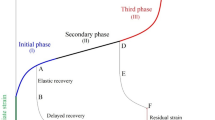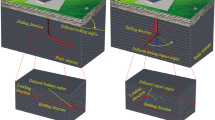Abstract
The increase of deep underground works has led to many concerns in relation to the dynamic characteristics of rocks subject to heating treatment, including underground rock blasting. For revelation of the dynamic mechanical properties of rocks subject to heating treatment, the granites treated after 25 °C, 100 °C, 200 °C, 300 °C, 400 °C, and 500 °C, respectively, were subject to dynamic tensile and compression tests using split Hopkinson pressure bar (SHPB). Granite specimens treated after different temperatures were compared in respect of dynamic mechanical strength, energy transfer rate, macroscopic and microscopic failure forms, and elastic modulus. The dynamic statistical damage constitutive model of granites subject to heating treatment was constructed with the impact factors relating to temperature introduced to the damage evolution equation for normal temperature statistics and the statistical damage body introduced to the viscoelastic constitutive model. The dynamic fracture characteristics of granites subject to heating treatment were revealed by using XRD and SEM methods to examine the micro-fracture mechanism of these specimens and processing images on Python-Opencv (an open-source library). Results showed the dynamic tensile strength, elastic modulus, and energy transfer rate of granites have a significant temperature effect. The tendency of the model curve is generally consistent with that of the measured stress–strain relation. The relative content of Glimmer in granites gradually increases with temperature, and the fracture mechanism of granites transits from brittle fracture to brittle fracture and local ductile fracture. Through image processing analysis, the peak pore area and crack length of the granites subject to heating treatment are significantly larger than that of the granite specimens at normal temperature.















Similar content being viewed by others
Data Availability
The author declares that there are no conflicts of interest regarding the publication of this paper.In addition, all the data involved in the paper can be used by the publishing house.
References
Debashis D, Brijes M, Neel G (2021) Understanding the influence of petrographic parameters on strength of differently sized shale specimens using XRD and SEM. Inter J Min Sci Tech 31:953–961. https://doi.org/10.1016/J.IJMST.2021.07.004
Demirdag S, Tufekci K, Kayacan R et al (2009) Dynamic mechanical behaviorof some carbonate rocks. Inter J Rock Mech Min Sci 47(2):307–312. https://doi.org/10.1016/j.ijrmms.2009.12.003
Du SJ, Liu H, Zhi HT, Chen HH (2004) Testing study on mechanical properties of post-high-temperature granite. Chn J Rock Mech Eng 14:2359–2364
Funatsu T, Shimada H, Matsui K, Seto M (2014) Effects of temperature and confining pressure on mixed-mode (I-II) and mode II fracture toughness of Kimachi sandstone. Inter J Rock Mech Min Sci 67:1–8. https://doi.org/10.1016/j.ijrmms.2013.12.009
Kwangmin K, John K, Mark N (2014) Effect of rapid thermal cooling on mechanical rock properties. Rock Mech Rock Eng 47:2005–2019. https://doi.org/10.1007/s00603-013-0523-3
Nasseri M, Schubnel A, Young R (2006) Coupled evolutions of fracture toughness and elastic wave velocities at high crack density in thermally treated Westerly granite. Inter J Rock Mech Min Sci 44:601–616. https://doi.org/10.1016/j.ijrmms.2006.09.008
Ping Q, Zhang CL, Sun HJ et al (2020) Dynamic mechanical properties and energy dissipation analysis of sandstone after high temperature cycling. Shock Vibr 2020:1–11. https://doi.org/10.1155/2020/8848595
Roy DG, Singh TN (2016) Effect of heat treatment and layer orientation on the tensile strength of a crystalline rock under Brazilian test condition. Rock Mech Rock Eng 49:1663–1677. https://doi.org/10.1007/s00603-015-0891-y
Shao SS, Wasantha PLP, Ranjith PG, Chen BK (2014) Effect of cooling rate on the mechanical behavior of heated Strathbogie granite with different grain sizes. Inter J Rock Mechanics and Min Sci 70:381–387. https://doi.org/10.1016/j.ijrmms.2014.04.003
Wang ZL, Hao SY, Zheng J et al (2020a) Study on energy properties and failure behaviors of heat-treated granite under static and dynamic compression. Mech Adv Mater Struct 27:462–472. https://doi.org/10.1080/15376494.2018.1479808
Wang C, Zhan S F, Xie M Z, Wang C, Cheng L P et al (2020b) Damage characteristics and constitutive model of deep rock under frequent impact disturbances in the process of unloading high static stress. Rock Soil Mech 38:2286–2296 + 2305. https://doi.org/10.1155/2020/2706091
Xia KW, Yao W (2015) Dynamic rock tests using split Hopkinson(Kolsky)bar system-a review. J Rock Mech Geot Eng 7:27–59
Xing XM, Zhu YK, Yuan ZH et al (2021) Predicting mining-induced dynamic deformations for drilling solution rock salt mine based on probability integral method and Weibull temporal function. Inter J Rem Sens 42:639–671. https://doi.org/10.1080/01431161.2020.1813345
Xu XL, Karakus M (2018) A coupled thermo-mechanical damage model for granite. Inter J Rock Mech Min Sci 103:195–204. https://doi.org/10.1016/j.ijrmms.2018.01.030
Xu JH, Kang Y, Wang ZF et al (2020) Dynamic mechanical behavior of granite under the effects of strain rate and temperature. Inter J Geome. https://doi.org/10.1061/(ASCE)GM.1943-5622.0001583
Zhao YS, Wan ZJ, Feng ZJ et al (2012) Triaxial compression system for rock testing under high temperature and high pressure. Inter J Rock Mech Min Sci 52:132–138. https://doi.org/10.1016/j.ijrmms.2012.02.011
Zhou Y, Xia K, Li XB et al (2011) Suggested methods for determining the dynamic strength parameters and modeI fracture toughness of rock materials. Inter J Rock Mech Min Sci 49:105–112. https://doi.org/10.1016/j.ijrmms.2011.10.004
Zuo JP, Wang XS, Mao DQ (2014) SEM in-situ study on the effect of offset-notch on basalt cracking behavior under three-point bending load. Eng Frac Mech 131:504–513. https://doi.org/10.1016/j.engfracmech.2014.09.006
Acknowledgements
This work was financially supported by the National Key Research and Development Program of China (No. 2021YFC2902103), the National Natural Science Foundation of China (No. 51934001), and the Basic Scientific Research Expenses of Central Universities (No. 800015Z11A24).
Author information
Authors and Affiliations
Corresponding author
Ethics declarations
Conflict of interest
The authors declare no competing interests.
Additional information
Responsible Editor: Zeynal Abiddin Erguler
Appendices
Appendix 1 Histogram equalization

Appendix 2 Convolution kernel processing

Appendix 3 Close operation
Import cv2.
import numpy as np.
from matplotlib import pyplot as plt.
img = cv2.imread("path",1).
kernel1 = cv2.getStructuringElement(cv2.MORPH_RECT, (10, 10)).
kernel2 = cv2.getStructuringElement(cv2.MORPH_ELLIPSE, (10, 10)).
kernel3 = cv2.getStructuringElement(cv2.MORPH_CROSS, (10, 10)).
closing1 = cv2.morphologyEx(img, cv2.MORPH_CLOSE, kernel1).
closing2 = cv2.morphologyEx(img, cv2.MORPH_CLOSE, kernel2).
closing3 = cv2.morphologyEx(img, cv2.MORPH_CLOSE, kernel3).
plt.figure(figsize = (20,15)).
plt.subplot(141),plt.imshow(img),plt.title('Original'),plt.xticks([]), plt.yticks([]).
plt.subplot(142),plt.imshow(closing1),plt.title('RECT'),plt.xticks([]), plt.yticks([]).
plt.subplot(143),plt.imshow(closing2),plt.title('ELLIPSE'),plt.xticks([]), plt.yticks([]).
plt.subplot(144),plt.imshow(closing3),plt.title('CROSS'),plt.xticks([]), plt.yticks([]).
cv2.imwrite("path1",closing1).
cv2.imwrite("path2",closing2).
cv2.imwrite("path3",closing3).
plt.show().
Appendix 4 Skeleton extraction
Import cv2.
from skimage import morphology.
import numpy as np.
img = cv2.imread("path",0).
_,binary = cv2.threshold(img,200,255,cv2.THRESH_BINARY_INV).
cv2.imwrite("path1",binary).
binary[binary = = 255] = 1.
skeleton0 = morphology.skeletonize(binary).
skeleton = skeleton0.astype(np.uint8)*255.
cv2.imwrite("path2",skeleton).
Rights and permissions
Springer Nature or its licensor (e.g. a society or other partner) holds exclusive rights to this article under a publishing agreement with the author(s) or other rightsholder(s); author self-archiving of the accepted manuscript version of this article is solely governed by the terms of such publishing agreement and applicable law.
About this article
Cite this article
Wang, Y., Luo, L., Chen, J. et al. Dynamic mechanical behavior and macroscopic and microscopic characteristics of granites subject to heating treatment. Arab J Geosci 16, 112 (2023). https://doi.org/10.1007/s12517-022-11061-x
Received:
Accepted:
Published:
DOI: https://doi.org/10.1007/s12517-022-11061-x




